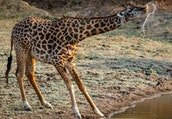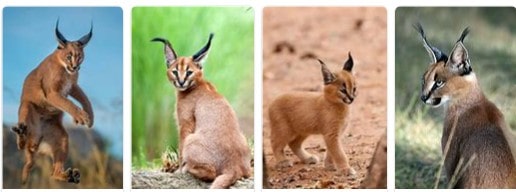- 1. Africa Caracal Physical Description Caracals have a distinctive appearance with their long legs, relatively short tail, and tufted ears. They have a compact and muscular build, with males being larger than females. Adult caracals typically weigh between 13 to 18 kilograms (29 to 40 pounds) and stand around 40 to 50 centimeters (16 to 20 inches) at the shoulder. They have a reddish-brown to tawny coat with white undersides and black tufts on their ears.
- 2. Africa Caracal Distribution and Habitat: African caracals are found across various habitats in Africa, including savannas, grasslands, woodlands, scrublands, and semi-deserts. They have a wide distribution range that extends from sub-Saharan Africa, including countries such as Kenya, Tanzania, South Africa, and Botswana.
- 3. Africa Caracal Hunting and Diet: Caracals are skilled hunters and primarily feed on small to medium-sized mammals such as rodents, hares, and small antelopes. They are known for their exceptional jumping abilities and can perform impressive leaps to catch birds in mid-air. They are also capable of taking down prey larger than themselves. Caracals are primarily nocturnal, hunting primarily during the night.
- 4. Africa Caracal Behavior and Adaptations: Caracals are solitary animals, except during the mating season or when a female is rearing her young. They are highly territorial and mark their ranges with scent markings and claw scratching. Caracals have keen eyesight and hearing, aided by their large, tufted ears, which are believed to help with sound localization and communication.
- 5. Africa Caracal Reproduction: Female caracals reach sexual maturity at around one year of age, while males mature slightly later. Breeding can occur throughout the year, although peaks may vary depending on the region. After a gestation period of approximately 2 to 3 months, a female caracal gives birth to a litter of typically 1 to 6 kittens. The young remain with their mother until they are independent, learning essential hunting and survival skills from her.
- 6. Africa Caracal Conservation Status: The African caracal is listed as a species of "Least Concern" by the International Union for Conservation of Nature (IUCN). However, localized threats such as habitat loss, human-wildlife conflicts, and illegal hunting can impact certain populations. In some regions, caracals are hunted for their fur or considered a threat to livestock and may face persecution.
Africa Caracal:
The caracal (Caracal caracal) is a medium-sized wild cat species found in various regions of Africa, as well as parts of the Middle East and Asia. Here are some key facts about the African caracal:
Africa Safari Tour Book online








 |
|  |
|  |
|  |
| 